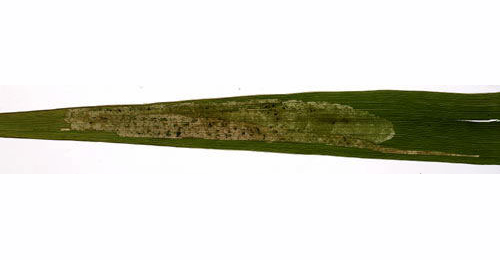|
||||||
|
DESCHAMPSIA. Hair-grasses. [Poaceae] |
|
Four species of Deschampsia are recorded in Britain. These include the native species and subspecies Alpine Hair-grass (D. cespitosa alpina), Bog Hair-grass (D. setacea), Small-flowered Hair-grass (D. cespitosa parviflora), Tufted Hair-grass (D. cespitosa cespitosa) and Wavy Hair-grass (D. flexuosa). The BSBI provide a downloadable plant crib for the Deschampsia caespitosa complex. Twenty-two British miners are recorded on Deschampsia. A key to the European miners recorded on Deschampsia is provided in Bladmineerders van Europa. Nearly 100 British miners or possible miners are recorded on grasses in Britain. It is recommended that adults of all miners on grasses be reared to be certain of their identity. |
Key for the identification of the known mines of British |
Note: Diptera larvae may live in a corridor mine, a corridor-blotch mine, or a blotch mine, but never in a case, a rolled or folded leaf, a tentiform mine or sandwiched between two more or less circular leaf sections in later instars. Pupation never in a cocoon. All mining Diptera larvae are leg-less maggots without a head capsule (see examples). They never have thoracic or abdominal legs. They do not have chewing mouthparts, although they do have a characteristic cephalo-pharyngeal skeleton (see examples), usually visible internally through the body wall. The larvae lie on their sides within the mine and use their pick-like mouthparts to feed on plant tissue. In some corridor miners frass may lie in two rows on alternate sides of the mine. In order to vacate the mine the fully grown larva cuts an exit slit, which is usually semi-circular (see Liriomyza huidobrensis video). The pupa is formed within the hardened last larval skin or puparium and as a result sheaths enclosing head appendages, wings and legs are not visible externally (see examples). See Key to non-Diptera. |
1# > Details unknown. Pupation internal (Spencer, 1972b: 104, as deschampsiae). |
|
Cerodontha imbuta (Meigen, 1938) [Diptera: Agromyzidae]. |
1# > ? Leaf-miner: Details of mine unknown. Puparium reddish |
|
Liriomyza richteri Hering, 1927 [Diptera: Agromyzidae]. |
1# > Leaf-mine: Details unknown. |
|
Liriomyza orbona (Meigen, 1830) [Diptera: Agromyzidae]. |
1a > Leaf-miner: Larvae either singly or several in leaf, then forming large blotch-mine, feeding first up and then down the leaf. Pupation external (Spencer, 1976: 119). Shallow upper-surface corridor, without full-depth sections, starting high in the leaf. Initially the corridor runs up, but soon it changes direction, quickly widening. In Deschampsia generally one mine per leaf, occupying its entire width; in Glyceria there mostly are serveral mines that merge in the end. Pupation outside the mine; the puparium often sticks to the leaf. Puparium black or dark red |
|
Agromyza lucida Hendel, 1920 [Diptera: Agromyzidae]. |
1b > Leaf-miner: Normally several larvae feed together. Pupation in the mine. Puparium shining black (Spencer, 1976: 198). Broad elongated blotch. Frass greenish. Larvae generally communal. Pupation within the mine. The black puaria are individially anchored within the mine with a silken thread attached at their rear end. Distinguishable from C. incisa only by means of the larva. |
|
Cerodontha pygmaea (Meigen, 1830) [Diptera: Agromyzidae]. |
1c > Leaf-miner: Larvae feeding singly, forming a long, widening mine on the upper surface of the leaf, which is generally limited to one side of the leaf. Pupation external, puparium glued to the leaf near the end of the mine (Spencer, 1976: 128). Broad corridor, generally beginning near the leaf margin or close to the leaf tip. Most of the times the mine remains at one side of the midrib. The mine is upper-surface, but has some full depth, translucent spots here and there. Frass in rather regularly scattered grains. Pupation outside the mine. According to Dempewolf (2004a) only the male genitalia enable a reliable discrimination from A. abipennis and A. graminicola. |
|
Agromyza nigripes Meigen, 1830 [Diptera: Agromyzidae]. |
1d > Leaf-miner: Long, narrow, whitish mine. Pupation internal (Spencer, 1976: 453); anterior spiracles projecting through the epidermis. Whitish, upper-surface, rather narrow corridor with comparatively large frass grains that are laying further apart than their diameter. Pupation within the mine. The anterior spiracles of the orange-brown puparium penetrate the epidermis. |
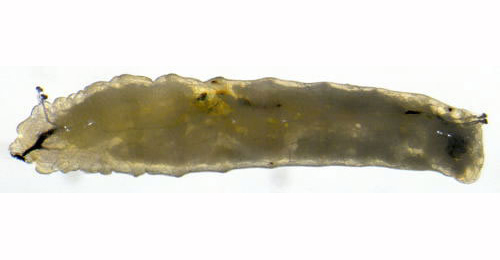 Chromatomyia nigra larva, lateral Image: © Willem Ellis (Bladmineerders van Europa) |
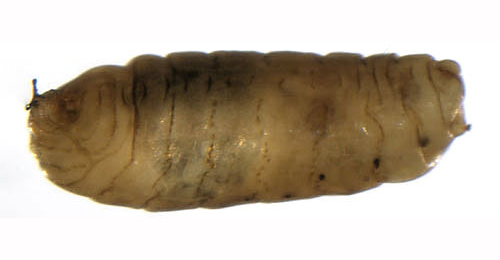 Chromatomyia nigra pupa, lateral Image: © Willem Ellis (Bladmineerders van Europa) |
|
Chromatomyia nigra (Meigen, 1830) [Diptera: Agromyzidae]. |
1e > Leaf-miner: Narrow whitish mine, with frass in distinct black lumps. Pupation internal (Spencer, 1976: 422). Whitish, upper-surface, descending corridor, about halfway up the blade. Frass in distinct black grains that are lying further apart than their diameter. Pupation in the mine. |
|
Chromatomyia fuscula (Zetterstedt, 1838) [Diptera: Agromyzidae]. |
1f > Leaf-miner: Larvae feed singly, forming an upper surface linear-blotch mine. Pupation either internal or external, with the puparium loosely glued to the leaf (Spencer, 1976: 91). Oviposition near the leaf margin, at some distance from the leaf tip. From there develops an upper-surface corridor-blotch. At first the mine ascends as a narrow corridor towards the leaf tip, then the direction turns and the mine, steadily widening, descends in the direction of the leaf base. Frass irregular, in rather coarse grains. Larva solitary. Pupation mostly outside the mine; in that case the puparium often sticks to the leaf. |
|
|
Agromyza albipennis Meigen, 1830 [Diptera: Agromyzidae]. |
1g > Leaf-miner: A narrow whitish linear mine, running down the leaf from the apex, with frass in two rows of separate grains. Pupation external (Spencer, 1976: 246). Narrow corridor from start to end, whitish, uppper- or lower-surface, genarally running downwards. Mine often along the leaf margin. Frass in distict grains of regular size, alternating along the sides of the corridor. Pupation outside the mine. |
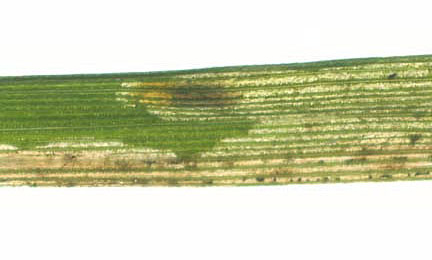 Mine of Liriomyza flaveola on Festuca gigantea Image: © Willis Ellis (Bladmineerders van Europa) |
|
Liriomyza flaveola (Fallén, 1823) [Diptera: Agromyzidae]. |
1h > Leaf-miner: Upper surface, deep, narrow mine; frass in two regular rows; pupation external (Spencer, 1972b: 60, as flavoscutellaris). A short, descending corridor in a leaf sheath. Fress in few, isolated blad granules. Pupation outside the mine. |
|
Metopomyza flavonotata (Haliday, 1833) [Diptera: Agromyzidae]. |
|
Key for the identification of the known mines of British |
Note: The larvae of mining Coleoptera, Hymenoptera and Lepidoptera may live in a corridor mine, a corridor-blotch mine, a blotch mine, a case, a rolled or folded leaf, a tentiform mine or sandwiched between two more or less circular leaf sections in later instars. Larva may pupate in a silk cocoon. The larva may have six legs (although they may be reduced or absent), a head capsule and chewing mouthparts with opposable mandibles (see video of a gracillarid larva feeding). Larvae of Hymenoptera and Lepidoptera usually also have abdominal legs (see examples). Frass, if present, never in two rows. Unless feeding externally from within a case the larva usually vacates the mine by chewing an exit hole. Pupa with visible head appendages, wings and legs which lie in sheaths (see examples). |
1a > Leaf-miner: Tufted hair-grass and blue moor-grass are the main foodplants, the larvae forming gallery mines. Gradually widening corridor, running either upwards or down. All frass is deposited in the earliest part of the mine. Often 2-3 larvae in a mine; in grasses with broad leaves sometimes more than one mine in a leaf. |
|
Elachista adscitella Stainton, 1851 [Lepidoptera: Elachistidae]. |
1b > Leaf-miner: Corridor, 15 cm in the end, descending from the leaf tip. The mine is whtish and shallow at first, then becomes deeper, yellowish white, and more transparent. Pupation external; pupa, not in a cocoon, attached to the leaf. |
|
Elachista albidella Nylander, 1848 [Lepidoptera: Elachistidae]. |
1c > Leaf-miner: The larva mines from the grass tip downwards and the mine occupies half or the whole of the leaf blade width. A whitish blotch is formed with characteristic narrow streaks of frass. Full depth blotch, slightly inflated, descending from the leaf tip, occupying half or the entire width of the blade. The larva may move and make a new mine elsewhere. In the latter case the mines are fairly short; otherwise an entire blade may be mined out. Frass in a some narrow greyish brown streaks. Pupation outside the mine. |
|
Elachista albifrontella (Hübner, 1817) [Lepidoptera: Elachistidae]. |
1d > Leaf-miner: Corridor widening while descending from the tip of the leaf. The mine is unusual because the sides are very irregularly scalloped out. Moreover, the mine is not evenly transparent, but rather yellowish green and motly, because the larva leaves patches of parenchyma uneaten, and does not feed full depth. Frass in a few irregular, interrupted length lines. Often 2-3 larvae in a mine. The larvae hibernate in the centre of the mine; after winter they leave their mine and pupate. |
|
Elachista apicipunctella Stainton, 1849 [Lepidoptera: Elachistidae]. |
1e > Leaf-miner: In autumn the larva makes a narrow corridor a few cm in length, in which it hibernates. In March it moves to a new leaf. Here a transparent, full depth mine is made that descends from the leaf tip, and occupies the entire width of the blade. Most frass is concentrated in the oldest, highest, part of the mine. The larva may leave its mine and restart elsewhere. Pupation outside the mine |
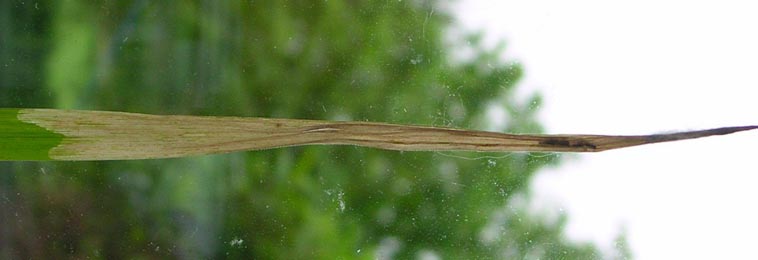 Mine of Elachista argentella on Dactylis glomerata Image: © Ben Smart (British leafminers) |
|
Elachista argentella (Clerck, 1759) [Lepidoptera: Elachistidae]. |
1f > Leaf-miner: Mine a descending and widening corridor, in the end an elongate blotch that may occupy the entire width of the leaf. The mine contracts somehat, narrowing the leaf. Frass in some elongate lumps in the centre of the mine. |
|
Elachista bisulcella (Duponchel, 1843) [Lepidoptera: Elachistidae]. |
1g > Leaf-miner: Flat, whitish. Pupation outside the mine. |
|
Elachista canapennella (Hübner, 1813) [Lepidoptera: Elachistidae]. |
1h > Leaf-miner: Mine generally descending from the leaf tip. The mine may occupy the space between leaf margin and midrib, but may also occupy the entire width of the leaf. Most frass accumulated in the oldest part of the mine. Pupation external; the pupa is attached to the leaf without a cocoon Larval head and prothoracic shield dark brown, ody yellowish white, with a pair of orange red latero-dorsal length lines; ventrally another such line, medially. |
|
Elachista cinereopunctella (Haworth, 1828) [Lepidoptera: Elachistidae]. |
1i > Leaf-miner: In spring a short corridor is made that is almost stuffed with frass. After hibernation this mine is vacated, and the larva then makes a number of elongated blotches, all descending from the leaf tip. These latter mines are whitish, with irregularly scattered frass. |
|
Elachista humilis Zeller, 1850 [Lepidoptera: Elachistidae]. |
1j > Leaf-miner: The larva starts mining near a leaf tip in early autumn. This early mine approximates to being linear but is very erratic in its course. In earl winter the the larva usually moves to anew leaf. This second mine usually takes the form of a compact but irregularly brownish blotch close to or often within the area of purplish discoloration of the dying leaf tip. Occasionally the larva does not change mines but extends the one made in autumn. Pupation takes place in a concealed place amongst debris or between closely applied leaves (Bland and Knill-Jones, 1988). Egg generally at the underside of the leaf tip. From September until the following spring a narrow meandering corridor is made. Then gradually the corridor widens to nearly the full width of the leaf. Generally the larvae make a new mine in early winter, obviously without the initial corridor. The mine in this stage is brown and situated close to (or within) the red coloured dying apical part of the leaf. Frass in large elongate dark spots. Pupation external. |
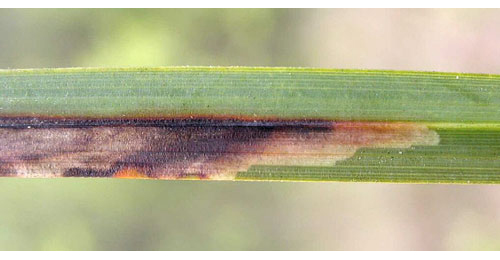 Mine of Elachista gleichenella on Carex flacca Image: © Jean-Yves Baugnée (Bladmineerders van Europa) |
|
Elachista gleichenella (Fabricius, 1781) [Lepidoptera: Elachistidae]. |
1k > Leaf-miner: Long, narrow, white corridor, descending from close to the leaf tip to the leaf base or even stem. Frass in an inconspicuous grey line. From the stem the larva may enter a new leaf (Steuer, 1987a; Bland, 1996a). |
|
Elachista luticomella Zeller, 1839 [Lepidoptera: Elachistidae]. |
1l > Leaf-miner: Initially a narrow brownish mine with blackish frass at its base, then moves to another leaf, forming a broader mine. Both mines can pucker the blade. |
|
Elachista obliquella Stainton, 1858 [Lepidoptera: Elachistidae]. |
1m > Leaf-miner: Mines downwards from leaf tip to stem. Makes a long narrow yellowish mine. May be up to four larvae in one leaf. Long narrow yellowish corridor, descending from the leaf tip to its base; at times 3-4 larvae in a leaf. Often several larvae in a communal mine. Pupation outside the mine. |
|
Elachista stabilella Stainton, 1858 [Lepidoptera: Elachistidae]. |
| Last updated 03-Jul-2019 Brian Pitkin | ||

